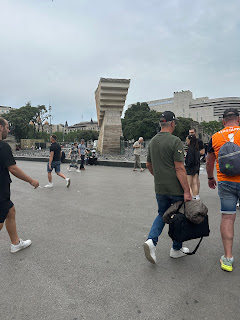Montserrat Trip

Montserrat
Connection to POL 150
Montserrat relates to nationalism, especially Catalan nationalism because it's a symbol of Catalan identity and resistance. Montserrat Monastery is home to La Moreneta, the Black Madonna, a religious icon and one of Catalonia’s most cherished symbols. Over centuries, the site became not only a spiritual center, but also a cultural stronghold where the Catalan language and identity were preserved, especially during times of repression. During the Franco dictatorship, when Catalan culture and language were outlawed in public life, Montserrat was one of the few places where Catalan was still spoken and celebrated, often in secret. This place is also a site of cultural and political resistance. Montserrat became a sanctuary for intellectuals, poets, and political dissidents. Monks there actively resisted Francoist censorship and supported movements for democracy and Catalan autonomy. It served as a moral and symbolic counterweight to the Spanish state, representing a Catalonia that could not be silenced. In this way, Montserrat aligned with the nationalist goal of preserving a unique Catalan identity distinct from the rest of Spain. Montserrat is also viewed as a sacred ground for the Catalan nation. Catalan flags and independence symbols are often seen there, especially on important cultural or political anniversaries. Politicians and activists frequently invoke Montserrat in speeches and literature as a symbol of endurance, faith, and national spirit.
Connection to POL 130
Montserrat relates to ethnic conflict, particularly the tensions between Catalonia and the Spanish state, by serving as a symbol and safe haven for grievances and opportunities tied to ethnic and national identity. While not a site of violence, it is deeply embedded in the cultural and symbolic dimension of ethnic conflict, where identity, repression, and resistance intersect. In the framework of ethnic conflict, grievances often stem from perceived or real injustices against an ethnic or national group. Montserrat plays a role in reflecting and amplifying these grievances like cultural suppression. Under Franco’s dictatorship (1939–1975), the Catalan language and identity were systematically repressed. Public use of Catalan was banned, including in schools, government, and media. Montserrat Monastery became one of the few places where Catalan was spoken, printed, and celebrated, giving the Catalan people a refuge for their culture and identity. Religious and National Unity: The Black Madonna (La Moreneta), housed at Montserrat, became a religious and ethnic symbol for Catalans, blending Catholicism with regional identity. Franco’s regime promoted Spanish Catholicism as a unifying tool — but Catalonia maintained its own distinct religious-cultural narrative through Montserrat, reinforcing feelings of exclusion from the Spanish national project. In summary Montserrat helps explain how ethnic conflict isn't always about armed struggle, it can also be about the fight to keep identity alive. The mountain and monastery embody both the pain of repression and the hope of cultural survival, making it central to understanding the Catalan-Spanish dynamic.
Compare and Contrast

New Knowledge
After visiting Montserrat, I learned about how Catalan culture was repressed under Franco, and how places like Montjuïc became sites of punishment while Montserrat became spaces of cultural preservation, gave me a much deeper appreciation of how political power shapes memory, identity, and participation. I also came to see how nonviolent resistance and symbolic spaces play a central role in Spanish and Catalan history, shaping everything from language rights to nationalist movements. Ultimately, this experience helped me understand that in Spain, culture itself can be a form of political resistance, and historical memory remains a living, contested part of everyday life. Top three benefits for me was that I gained a deeper insight into Spain's regional identities and conflicts, I was able to witness the role of symbolic spaces in political struggles, and lastly I am able to connect historical events to ongoing political debates.





Comments
Post a Comment